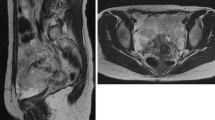Abstract
Polypoid endometriosis is a benign, rare variant of endometriosis which forms multiple polypoid nodules in the female pelvis mimicking malignant tumors; however, it may rarely cause malignant transformation. We report magnetic resonance imaging findings of a case of polypoid endometriosis with malignant transformation. Multiple high-signal intensity polypoid nodules in the cul-de-sac surrounded by low-signal intensity rim-like fibrous adhesion protruding to the posterior wall of the uterine body were demonstrated on T2-weighted images. The polypoid nodules showed weak contrast enhancement compared with that of uterine myometrium on post-contrast T1-weighted images, and slight high signal intensity on diffusion-weighted images with relatively high mean apparent diffusion coefficient. Reported cases of polypoid endometriosis showed intense contrast enhancement similar to that of uterine myometrium, and weak contrast enhancement similar to that of endometrial carcinoma may be suggestive for malignant transformation of polypoid endometriosis.


Similar content being viewed by others
References
Parker RL, Dadmanesh F, Young RH, Clement PB (2004) Polypoid endometriosis: a clinicopathologic analysis of 24 cases and a review of the literature. Am J Surg Pathol 28:285–297
Hansen K, Simon RA, Lawrence WD, Quddus MR (2012) Unilateral pelvic mass presenting in postmenopausal patients: report of two unusual cases. Ann Diagn Pathol 16:298–301
Takeuchi M, Matsuzaki K, Furumoto H, Nishitani H (2008) Case report: a case of polypoid endometriosis: MR pathological correlation. Br J Radiol 81:e118–e119. doi:10.1259/bjr/23847518
Kozawa E, Inoue K, Iwasa N, et al. (2012) MR imaging of polypoid endometriosis of the ovary. Magn Reson Med Sci 11:201–204
Kraft JK, Hughes T (2006) Polypoid endometriosis and other benign gynaecological complications associated with tamoxifen therapy—a case to illustrate features on magnetic resonance imaging. Clin Radiol 61:198–201
Marugami N, Hirohashi S, Kitano S, et al. (2008) Polypoid endometriosis of the ureter mimicking fibroepithelial polyps. Radiat Med 26:42–45. doi:10.1007/s11604-007-0188-5
Yamada Y, Miyamoto T, Horiuchi A, Ohya A, Shiozawa T (2014) Polypoid endometriosis of the ovary mimicking ovarian carcinoma dissemination: a case report and literature review. J Obstet Gynaecol Res 40:1426–1430. doi:10.1111/jog.12358
Syrcle SM, Pelch KE, Schroder AL, et al. (2011) Altered gene expression profile in vaginal polypoid endometriosis resembles peritoneal endometriosis and is consistent with increased local estrogen production. Gynecol Obstet Invest 71:77–86. doi:10.1159/000320736
Takeuchi M, Matsuzaki K, Nishitani H (2009) Diffusion-weighted magnetic resonance imaging of endometrial cancer: differentiation from benign endometrial lesions and preoperative assessment of myometrial invasion. Acta Radiol 50:947–953. doi:10.1080/02841850903099981
Wang J, Yu T, Bai R, et al. (2010) The value of the apparent diffusion coefficient in differentiating stage IA endometrial carcinoma from normal endometrium and benign diseases of the endometrium: initial study at 3-T magnetic resonance scanner. J Comput Assist Tomogr 34:332–337. doi:10.1097/RCT.0b013e3181d0f666
Kierans AS, Bennett GL, Haghighi M, Rosenkrantz AB (2014) Utility of conventional and diffusion-weighted MRI features in distinguishing benign from malignant endometrial lesions. Eur J Radiol 83:726–732. doi:10.1016/j.ejrad.2013.11.030
Imaoka I, Sugimura K, Masui T, et al. (1999) Abnormal uterine cavity: differential diagnosis with MR imaging. Magn Reson Imaging 17:1445–1455
Park BK, Kim B, Park JM, et al. (2006) Differentiation of the various lesions causing an abnormality of the endometrial cavity using MR imaging: emphasis on enhancement patterns on dynamic studies and late contrast-enhanced T1-weighted images. Eur Radiol 16:1591–1598
Author information
Authors and Affiliations
Corresponding author
Ethics declarations
Conflict of interest
The authors declare that they have no conflict of interest.
Informed consent
For this type of study, formal consent is not required, and the written informed consent of the patient was obtained for the MR examination.
Rights and permissions
About this article
Cite this article
Takeuchi, M., Matsuzaki, K., Bando, Y. et al. A case of polypoid endometriosis with malignant transformation. Abdom Radiol 41, 1699–1702 (2016). https://doi.org/10.1007/s00261-016-0696-9
Published:
Issue Date:
DOI: https://doi.org/10.1007/s00261-016-0696-9




